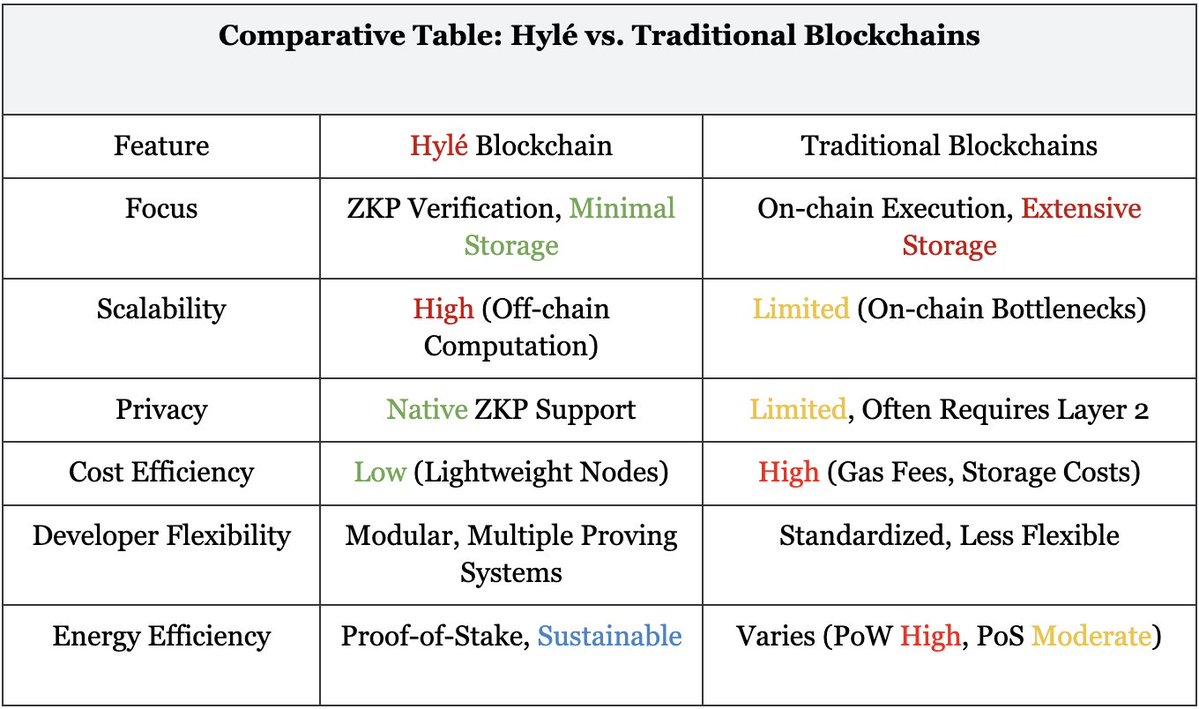
Hylé Blockchain, launched in 2024, is a French-initiated Layer 1 blockchain designed to transform decentralized applications through zero-knowledge proofs for the “unchained apps" - minimally yet sufficiently on-chain applications. Founded by Sylve Chevet (@sylvechv) and Lancelot de Ferrière le Vayer (@wraitii), it aims to address the limitations of traditional blockchains, such as slow finality, low throughput, high fees, and poor user experience. It aims to be a minimal, efficient settlement layer, focusing on verifying proofs rather than handling extensive on-chain computation, a game-changer for decentralized apps.
Unlike traditional blockchains, which require complete on-chain execution, @hyle_org positions itself as a lean blockchain focused on sequencing and settlement, leveraging ZKPs for verification.
In May 2024, Hylé closed a $2.6 million seed funding round, bringing its total to $3.4 million, led by Framework Ventures, with additional investments from Cherry Crypto, Fabric Ventures, Frst Capital, and Heartcore Capital.
Let’s break it down for clarity.

Hylé is engineered as a “lean blockchain,” focusing on sequencing, data availability, and settlement of ZKPs, rather than extensive on-chain storage and computation. It operates on a proof-of-stake consensus mechanism, ensuring decentralization and energy efficiency, a sustainable alternative to proof-of-work systems. Its modular architecture, inspired by projects like Celestia, separates execution, settlement, and data storage, enhancing scalability and interoperability (Hylé Overview).
Key technical features include:
This minimalist approach aims to solve blockchain trilemma issues—scalability, security, and decentralization—by offloading computation off-chain and verifying proofs on-chain, potentially offering a new paradigm for dApp development.
The protocol's architecture consists of three key components:

One of Hylé's most significant technical contributions is its implementation of pipelined proving, which fundamentally changes how blockchain transactions are processed 3.
Traditional ZK rollups face two major challenges:
Hylé solves these issues by separating transaction sequencing from proof settlement:
This approach provides several advantages:

Hylé introduces a novel approach to smart contract interoperability through proof composability. Unlike traditional systems where contract calls are nested (requiring full redeployment if inner contracts change), Hylé allows proofs to reference each other through metadata.
1. Compared to Traditional L1 Blockchains
Hylé offers several improvements over conventional Layer 1 blockchains:
2. Compared to ZK Rollups
While acknowledging that "rollups are good," Hylé's team believes we can do better. Key differentiators include:
3. Compared to Optimistic Rollups
Hylé avoids optimistic rollups' key limitations:

Hylé’s ZK-powered design unlocks a wide range of applications, particularly in areas requiring privacy and scalability:
While promising, Hylé faces challenges, including competing with established ecosystems like @Ethereum’s ZK-rollups (e.g., @ZKSync, @Starknet) and ensuring developer adoption. The complexity of ZK technology remains a hurdle even with abstraction efforts. However, with its substantial funding, active development, and focus on community, it seems likely to make significant strides in 2025, potentially launching its main-net later this year and expanding its ecosystem.

This table highlights Hylé’s potential to address key blockchain limitations, offering a fresh approach to scalability and privacy.
As a relatively new entrant (founded in 2024), Hylé represents an ambitious vision for blockchain architecture. Its technical innovations address fundamental limitations in current systems, particularly around:
The project's success will depend on ecosystem growth and real-world adoption. However, its novel approach positions it as a potential leader in the next generation of blockchain infrastructure.

For more articles, visit https://www.hozk.io/journal. Email contact@hozk.io for details about becoming a contributor.